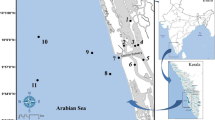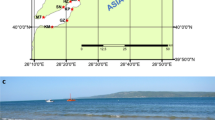Abstract
The benthic microbial food web can be responsible for a large proportion of benthic carbon cycling yet there are few data on the trophic interactions between this food web and macrobenthos. A large-scale field experiment was conducted to investigate effects of eliminating the polychaete Arenicola marina on benthic microbes (prokaryotes, heterotrophic and autotrophic protists) and metazoan meiofauna in a marine intertidal flat of the North Sea, Germany. Over a period of 2 years, quantity and composition of micro- and meiobenthos from unmanipulated sites were compared to those from sites deplete of lugworms. These grazer treatments were cross-classified with different sediment characteristics (low- and mid-intertidal areas). Lugworm removal resulted in an initial increase in abundance of prokaryotes and nanoflagellates, which became less pronounced in the second year. Ciliates were not affected quantitatively, but in the absence of lugworms, diversity and the proportion of carnivorous forms increased. Meiobenthos (nematodes, ostracods and copepods) were affected only moderately. The observed changes are probably due to a combination of release from grazing/predation pressure, changes in the species composition of higher trophic levels (namely large polychaetes) and altered environmental conditions (such as depth of the oxygenated layer and sediment grain size). Spatial differences between sites of different tidal exposure/grain size appeared to be as large as temporal differences during the 2 years following the manipulation of the system. We conclude that in intertidal sediments, indirect effects due to habitat transformation are as important as direct biological interactions (grazing pressure and competition) for the dynamics of the benthic microbial food web.





Similar content being viewed by others
References
Adrian R, Wickham SA, Butler NM (2001) Trophic interactions between zooplankton and the microbial community in contrasting food webs: the epilimnion and deep chlorophyll maximum of a mesotrophic lake. Aquat Microb Ecol 24:83–97
Alongi DM (1986) Quantitative estimates of benthic protozoa in tropical marine systems using silica gel: a comparison of methods. Est Coast Shelf Sci 23:443–450
Arndt H (1993) Rotifers as predators on components of the microbial web (bacteria, heterotrophic flagellates, ciliates)—a review. Hydrobiologia 255–256:231–246
Azam F, Fenchel T, Field JG, Gray JS, Meyer-Reil LA, Thingstad F (1983) The ecological role of water-column microbes in the sea. Mar Ecol Prog Ser 10:257–263
Baguley JG, Hyde LJ, Montagna PA (2004) A semi-automated digital microphotographic approach to measure meiofaunal biomass. Limnol Oceanogr Method 2:181–190
Bak RPM, Duyl FC, Nieuwland G (1995) Organic sedimentation and macrofauna as forcing factors in marine benthic nanoflagellate communities. Microb Ecol 29:173–182
Børsheim KY, Bratbak G (1987) Cell volume to cell carbon conversion factors for a bacterivorous Monas sp. enriched from seawater. Mar Ecol Prog Ser 36:171–175
Carey PG (1992) Marine interstitial ciliates: an illustrated key. natural history museum publications. Chapman and Hall, London
Caron DA, Lim EL, Miceli G, Waterbury JB, Valois FW (1991) Grazing and utilization of chroococcoid cyanobacteria and heterotrophic bacteria by protozoa in laboratory cultures and a coastal plankton community. Mar Ecol Prog Ser 76:205–217
Dietrich D, Arndt H (2000) Biomass partitioning of benthic microbes in a Baltic inlet: relationships between bacteria, algae, heterotrophic flagellates and ciliates. Mar Biol 136:309–322
Dye AH, Lasiak TA (1986) Microbenthos, meiobenthos and fiddler crabs: trophic interactions in a tropical mangrove sediment. Mar Ecol Prog Ser 32:259–264
Edler L (1979) Recommendations for marine biological studies in the Baltic Sea. Baltic Mar Biol Publ 5:1–38
Epstein SS, Gallagher ED (1992) Evidence for facilitation and inhibition of ciliate population growth by meiofauna and macrofauna on a temperate zone sandflat. J Exp Mar Biol Ecol 155:27–39
Epstein SS, Rossel J (1995) Enumeration of sandy sediment bacteria: search for optimal protocol. Mar Ecol Prog Ser 117:289–298
Fauchald K, Jumars PA (1979) The diet of worms: a study of polychaete feeding guilds. Oceanogr Mar Biol Annu Rev 17:193–284
Feller RJ, Warwick RM (1988) Energetics. In: Higgins RP, Thiel H (eds) Introduction to the study of meiofauna. Smithsonian Institution Press, Washington, DC, pp 181–196
Fenchel T (1969) The ecology of marine microbenthos. IV. Structure and function of the benthic ecosystem, its chemical and physical factors and the microfauna communities with special reference to the ciliated protozoa. Ophelia 6:1–182
Fenchel T (1982) Ecology of heterotrophic microflagellates. IV. Quantitative occurrence and importance as bacterial consumers. Mar Ecol Prog Ser 9:35–42
Fenchel T (1987) Ecology of protozoa: the biology of free-living phagotrophic protists. Madison, Wisconsin: Science Tech. Springer-Verlag, Berlin
Fry JC (1990) Direct methods and biomass estimation. In: Grigorova R, Norris JR (eds) Methods in microbiology, vol 22. Academic Press, London, pp 41–85
Gasol JM (1993) Benthic flagellates and ciliates in fine freshwater sediments: calibration of a live counting procedure and estimation of their abundances. Microb Ecol 25:247–262
Giere O (1993) Meiobenthology. the microscopic fauna in aquatic sediments. Springer, Berlin
Grossi V, Cuny P, Caradec S, Nerini D, Pancost R, Gilbert F (2006) Impact of feeding by Arenicola marina (L.) and ageing of faecal material on fatty acid distribution and bacterial community structure in marine sediments: An experimental approach. J Exp Mar Biol Ecol 336:54–64
Jürgens K, Jeppesen E (2000) The impact of metazooplankton on the structure of the microbial food web in a shallow, hypertrophic lake. J Plankton Res 22:1047–1070
Jürgens K, Arndt H, Zimmermann H (1997) Impact of metazoan and protozoan grazers on bacterial biomass distribution in microcosm experiments. Aquat Microb Ecol 12:131–138
Kahl KH (1930–1935) Urtiere oder Protozoa. I. Wimpertiere oder Ciliata (Infusoria). In: Dahl F (ed) Die Tierwelt Deutschlands Fischer Verlag, Jena, p 886
Kemp PF (1990) The fate of benthic bacterial production. Aquat Sci 2:109–124
Kraufvelin P (2007) Responses to nutrient enrichment, wave action and disturbance in rocky shore communities. Aquat Bot 87:262–274
Kristensen E (2001) Impact of polychaetes (Nereis spp. and Arenicola marina) on carbon biogeochemistry in coastal marine sediments: a review. Geochem Trans 2:92–104
Kuipers BR, de Wilde PAWJ, Creutzberg F (1981) Energy flow in a tidal flat ecosystem. Mar Ecol Prog Ser 5:215–221
Levinton JS, Bianchi TS (1981) Nutrition and food limitation of deposit feeders. I. The role of microbes in the growth of mud snails (Hydrobiidae). J Mar Res 39:531–545
Lynn DH, Small EB (2002) Phylum ciliophora. In: Lee JJ, Bradbury PC, Leedale GF (eds) An illustrated guide to the protozoa. Society of Protozoologists, Lawrence, Kansas, pp 371–656
Maclsaac EA, Stockner JG (1993) Enumeration of phototrophic picoplankton by autofluorescence microscopy. In: Kemp PF, Sherr BF, Sherr EB, Cole JJ (eds) Handbook of methods in aquatic microbial ecology. Lewis Boca Raton, Florida, USA, pp 187–197
Magurran AE (1988) Ecological diversity and its measurement. Princeton University Press, Princeton, NJ
Menden-Deuer S, Lessard EJ (2000) Carbon to volume relationships for dinoflagellates, diatoms, and other protist plankton. Limnol Oceanogr 45:569–579
Moorthi S, Berninger U-G (2006) Mixotrophic nanoflagellates in coastal sediments in the western Baltic Sea. Aquat Microb Ecol 45:79–87
Morrisey DJ (1988) Differences in effects of grazing by deposit-feeders Hydrobia ulvae (Pennant) (Gastropoda: Prosobranchia) and Corophium arenarium Crawford (Amphipoda) on sediment microalgal populations. I. Qualitative differences. J Exp Mar Biol Ecol 118:33–42
Putt M, Stoecker DK (1989) An experimentally determined carbon: volume ratio for marine “oligotrichous” ciliates from estuarine and coastal waters. Limnol Oceanogr 34:1097–1103
Reichardt W (1988) Impact of bioturbation by Arenicola marina on microbiological parameters in intertidal sediments. Mar Ecol Prog Ser 44:149–158
Reise K (1983) Experimental removal of lugworms from marine sand affects small zoobenthos. Mar Biol 74:327–332
Rice DL, Bianchi TS, Roper EH (1986) Experimental studies of sediment reworking and growth of Scoloplos spp. (Orbiniidae: Polychaeta). Mar Ecol Prog Ser 30:9–19
Sanders RW, Caron DA, Berninger U-G (1992) Relationships between bacteria and heterotrophic nanoplankton in marine and fresh waters: an inter-ecosystem comparison. Mar Ecol Prog Ser 86:1–14
Skibbe O (1994) An improved quantitative protargol stain for ciliates and other planktonic protists. Arch Hydrobiol 130:339–347
Van Hoey G, Guilini K, Rabaut M, Vincx M, Degraer S (2008) Ecological implications of the presence of the tube-building polychaete Lanice conchilega on soft-bottom benthic ecosystems. Mar Biol 154:1009–1019
Volkenborn N, Reise K (2006) Lugworm exclusion experiment: responses by deposit feeding worms to biogenic habitat transformations. J Exp Mar Biol Ecol 330:169–179
Volkenborn N, Reise K (2007) Effects of Arenicola marina on polychaete functional diversity revealed by large-scale experimental lugworm exclusion. J Sea Res 57:78–88
Volkenborn N, Polerecky L, Hedtkamp SIC, Beusekom JEE, De Beer D (2007) Bioturbation and bioirrigation extend the open exchange regions in permeable sediments. Limnol Oceanogr 52:1898–1909
Wickham S, Gieseke A, Beminger U-G (2000) Benthic ciliate identification and enumeration: an improved methodology and its application. Aquat Microb Ecol 22:79–91
Wickham S, Nagel S, Hillebrand H (2004) Control of epibenthic ciliate communities by grazers and nutrients. Aquat Microb Ecol 35:153–162
Acknowledgments
This work received financial support from the Knowledge Innovation Program of CAS (KZCX2-YW-417), the German Research Community (DFG BE 2279/3-1), the National Science Foundation of China (40706047 and 40576072) and the `100 Talents Project’ of the Chinese Academy of Sciences. We thank V. Smetacek, U. Bathmann (both AWI) and A. Lametschwandtner (University of Salzburg) for providing general support at the respective institutions. The help of our colleagues B. Auer, J. Matthiessen, M. Prast and K. Xu with various aspects of the study is gratefully acknowledged. We thank the associate editor Dr. P. Kraufvelin and three anonymous referees for helpful comments on the manuscript.
Author information
Authors and Affiliations
Corresponding author
Additional information
Communicated by P. Kraufvelin.
Rights and permissions
About this article
Cite this article
Lei, Y., Stumm, K., Volkenborn, N. et al. Impact of Arenicola marina (Polychaeta) on the microbial assemblages and meiobenthos in a marine intertidal flat. Mar Biol 157, 1271–1282 (2010). https://doi.org/10.1007/s00227-010-1407-7
Received:
Accepted:
Published:
Issue Date:
DOI: https://doi.org/10.1007/s00227-010-1407-7




